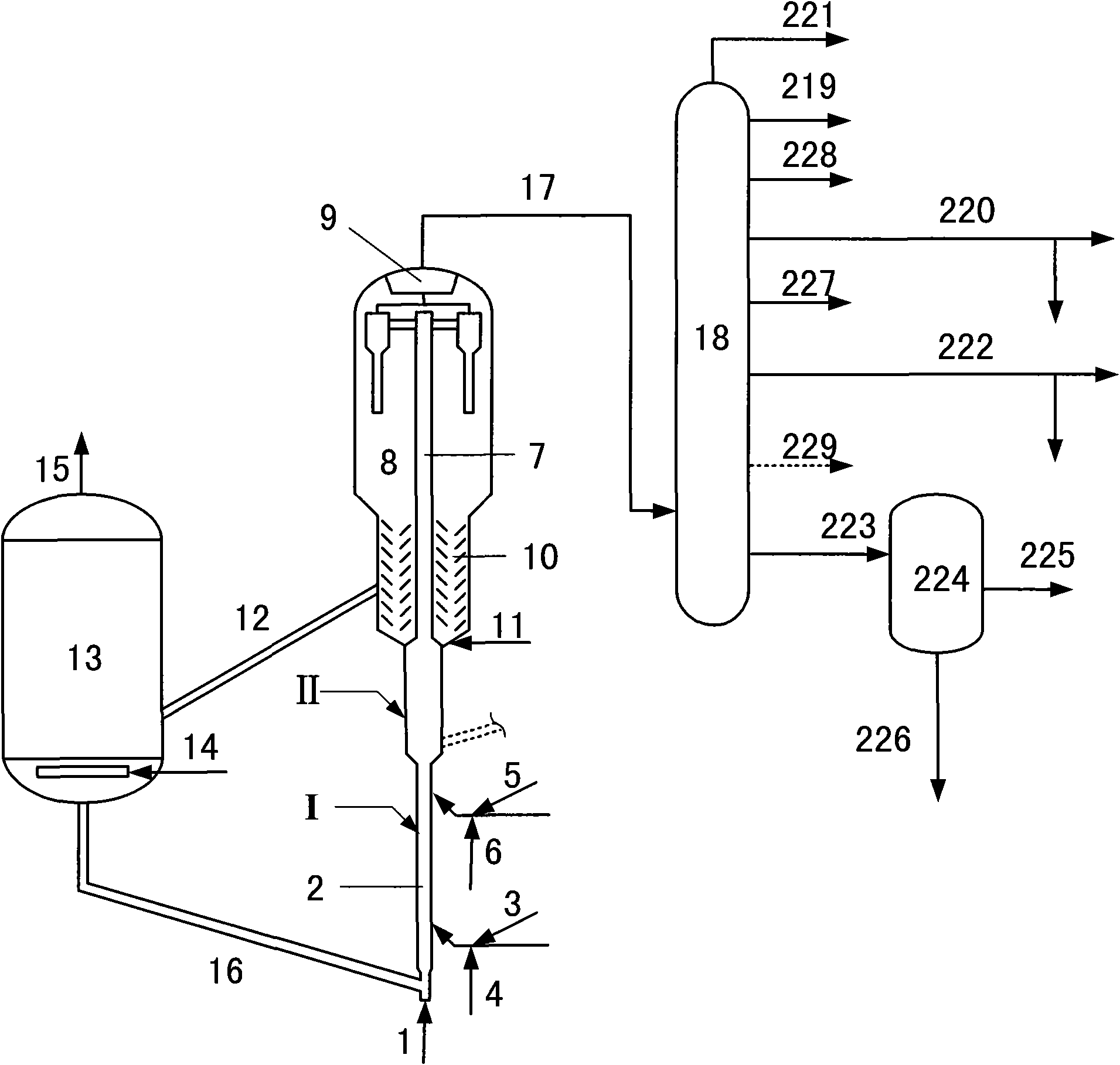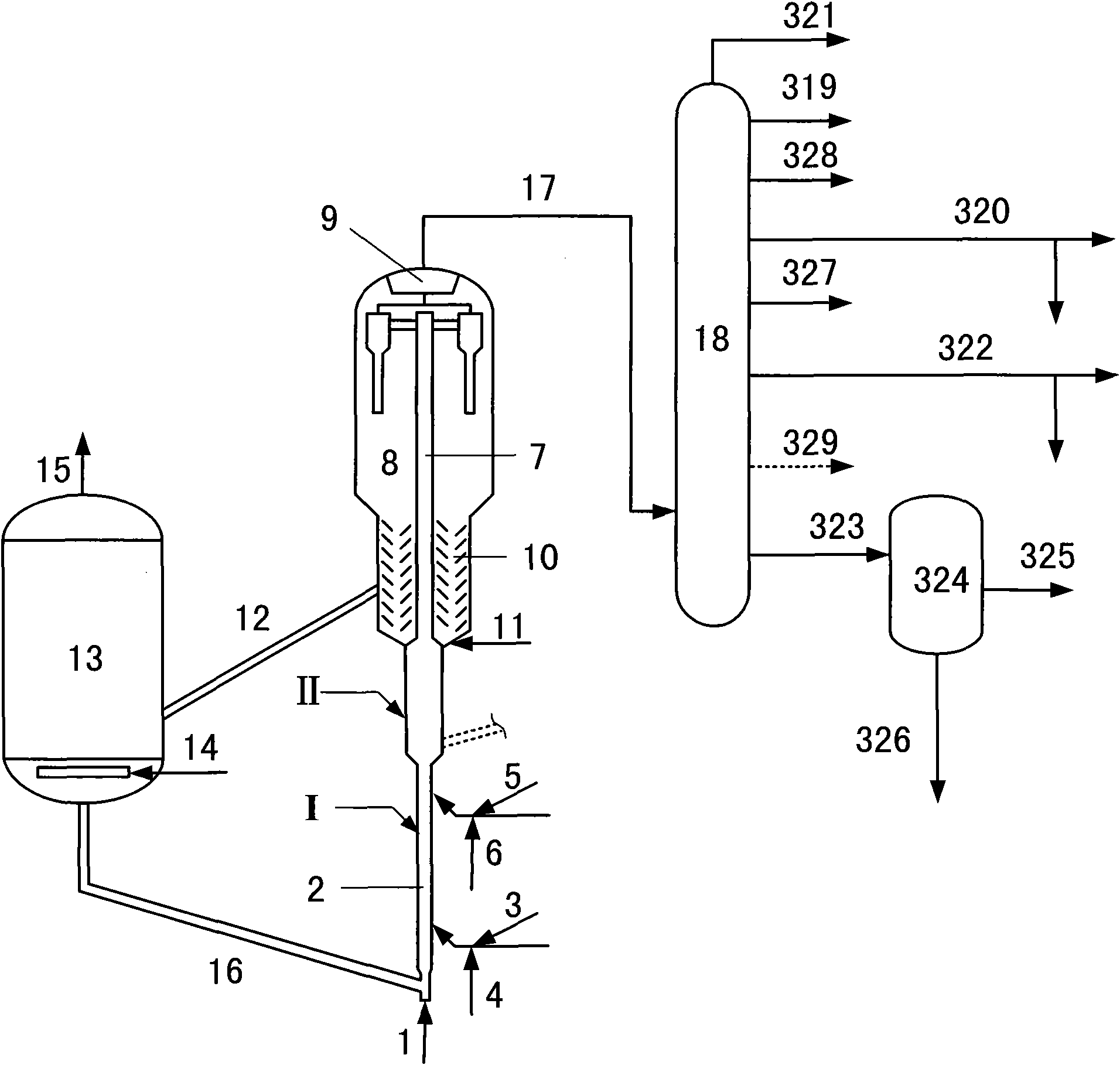Catalytic conversion method for preparing propylene and high-octane value gasoline
A technology of high-octane gasoline and catalytic conversion method, which is applied in catalytic cracking, cracking, organic chemistry, etc., and can solve the problems of poor selectivity of dry gas and coke
- Summary
- Abstract
- Description
- Claims
- Application Information
AI Technical Summary
Problems solved by technology
Method used
Image
Examples
Embodiment 1
[0097] This example follows figure 1 The process of the experiment is carried out, and the raw material oil A is directly used as the raw material oil of catalytic cracking, and the test is carried out on the medium-sized device of the riser reactor, and the raw material oil A enters the reaction zone I. Reaction temperature 530°C, weight hourly space velocity 30h -1 , the weight ratio of catalyst DL-1 to feedstock oil is 10, and the weight ratio of water vapor to feedstock oil is 0.15 to carry out the cracking reaction. The reaction product oil gas and the catalyst to be born with charcoal are separated in the settler, and the product is separated in the separation system according to The distillation range is cut to obtain products such as propylene, gasoline and catalytic wax oil. The operating conditions and product distribution are listed in Table 3.
Embodiment 2
[0102] This example follows the attached image 3 The process of the test is carried out, the catalyst is DL-1, and the raw material oil A is directly used as the raw material oil for catalytic cracking. The test is carried out on a medium-sized device with a riser reactor. The easily cracked raw material oil enters the middle and upper part of the reaction zone I, and the difficult cracked raw material The oil enters the bottom of the reaction zone I, and at the bottom of the reaction zone I, the difficult-to-crack raw oil is heated at a reaction temperature of 640 °C and a weight hourly space velocity of 180 -1 , the weight ratio of catalyst DL-1 to difficult-to-crack raw oil is 60, and the weight ratio of water vapor to difficult-to-crack raw oil is 0.20 to carry out the cracking reaction; Weight hourly space velocity 60h -1 , the weight ratio of catalytic cracking catalyst to easily cracked raw oil is 10, and the weight ratio of water vapor to easily cracked raw oil is 0....
Embodiment 3
[0107] This example follows Figure 4 The test is carried out according to the process, and the raw material oil B is directly used as the raw material oil for catalytic cracking, and the test is carried out on a medium-sized device with a riser reactor. The cracked raw material oil enters the middle and upper part of the reaction zone I, and butene enters the reaction zone I as the re-cracked raw material oil. Bottom, at the bottom of the reaction zone I, the re-cracked raw oil is heated at a reaction temperature of 630°C and a weight hourly space velocity of 180h -1 , the weight ratio of catalytic cracking catalyst to re-cracked feedstock oil is 62, and the weight ratio of water vapor to re-cracked feedstock oil is 0.20 to carry out the cracking reaction; Speed 65h -1 , the weight ratio of catalytic cracking catalyst to cracked raw oil is 10, and the weight ratio of water vapor to cracked raw oil is 0.15 to carry out the cracking reaction. In addition, the supplementary p...
PUM
 Login to View More
Login to View More Abstract
Description
Claims
Application Information
 Login to View More
Login to View More - R&D
- Intellectual Property
- Life Sciences
- Materials
- Tech Scout
- Unparalleled Data Quality
- Higher Quality Content
- 60% Fewer Hallucinations
Browse by: Latest US Patents, China's latest patents, Technical Efficacy Thesaurus, Application Domain, Technology Topic, Popular Technical Reports.
© 2025 PatSnap. All rights reserved.Legal|Privacy policy|Modern Slavery Act Transparency Statement|Sitemap|About US| Contact US: help@patsnap.com



